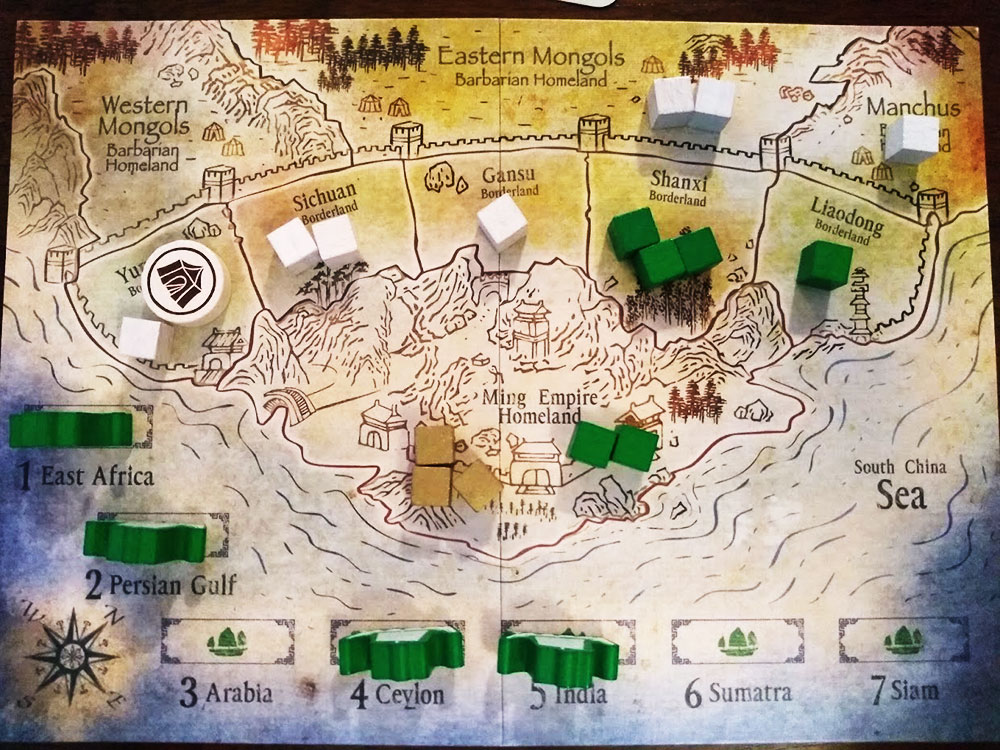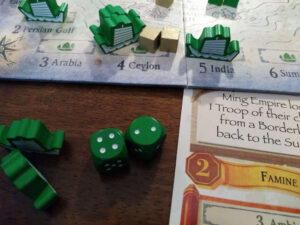 I don’t know much about Chinese history, but the background of the Ming voyages is pretty interesting. Apparently, the Ming Empire’s maritime fleet was more technologically advanced than that of Europe until the 18th century. According to legend, in the 1400s, Chinese treasure fleets circumnavigated the globe and discovered every continent except Europe. But is the gameplay as interesting as the history in this one, or has entertainment been lost to time?
I don’t know much about Chinese history, but the background of the Ming voyages is pretty interesting. Apparently, the Ming Empire’s maritime fleet was more technologically advanced than that of Europe until the 18th century. According to legend, in the 1400s, Chinese treasure fleets circumnavigated the globe and discovered every continent except Europe. But is the gameplay as interesting as the history in this one, or has entertainment been lost to time?
The Ming Voyages is an asymmetric strategy game from Surprised Stare Games designed by David J. Mortimer and Alan Paull for 1-2 players and plays in about 30 minutes.
Gameplay Overview:
The two players begin a game of Ming Voyages by each choosing a side, either the Ming Emperor or the Barbarian Overlord. The Emperor’s goal is to complete 7 treasure fleet journeys while protecting the Chinese Borderlands from barbarian invasion. The Overlord will attempt to take control of the 5 Borderlands before the Emperor succeeds in making all 7 voyages.
The primary mechanism of the game is a single deck of multi-use cards that have both Emperor and Barbarian actions on them as well as a number indicating the command point (CP) value of the card. On a player’s turn, they’ll play a single card from their hand and use it in one of several possible ways. The most common usage will be to convert the CP value (1 to 3) into actions of a single type. Most cards in the deck have both an Overlord special action (top portion) and an Emperor special action (bottom half). So, if possible, the player can use the special action corresponding to their side in lieu of the CP value of the card. Finally, a player may choose to reserve the card, placing it facedown in their play area for later use.

When the Emperor utilizes a card for its CP value, there are two main categories available to them: actions in defense of the Borderlands and actions contributing to the treasure fleet voyages. Actions belonging to the former category allow them to recruit and move troops, or to attack with their forces. This is how the Emperor can repel barbarian hordes from their Borderlands to stave off defeat. The second category involves actions focused on gaining gold through taxation, building Junk ships, and sending these fleets out on journeys from the South China Sea.
When playing a card for the CP value, the Overlord is primarily attempting to amass barbarian hordes, move them about the map, and invade the Chinese Borderlands. It’s also possible to build Settlements in Borderlands that are under their control, making it more difficult for the Emperor to oust them from those territories. Cards that are in the Overlord’s reserve can be used to increase the CP value of their actions, but this ability is unique to the Barbarian player.
When either side attacks the other, a battle is carried out using 3 dice for each player. Results are compared and the attack is resolved. If one player achieves a more powerful result type than the other, such as strong vs. moderate, then the loser must remove 2 armies from the battle. Attacks are resolved until only one side has pieces remaining in the Borderland, thus granted them control of the location.
Each round, once the Emperor has played a card and the Overlord has then played their card, they swap hands of cards. The main deck is also the game’s clock; there will be two eras, each of which ends once the deck runs out of cards.

Game Experience:
The Ming Voyages is reminiscent of games like Twilight Struggle, where two sides are locked in a tug of war, racing to claim victory first by playing multi-use cards for either action points or special “events.” This is certainly a game where repeated plays and increased familiarity with the cards will greatly enhance a player’s skill, probably to the point where a neophyte will have a tough time competing against a veteran.
This type of experience has the tendency to be off-putting to someone looking to explore a game for the first time and could push them away from giving it another try following a thorough trouncing by a seasoned opponent. On the other hand, unlike Twilight Struggle, Ming Voyages is a fairly quick game and it’s not as much of a commitment to get in another play. Plus, the depth of choice, strategy, and tactical nuance isn’t quite there in this one, so there’s a lot less information you’ll have to absorb and internalize.

The two asymmetric roles are fairly straightforward, with the Emperor pushing hard to complete voyages while the Overlord seeks to win through conquest. It feels like there’s more tactical maneuvering required to play the Emperor well, though. While your focus will be on building up your Junk fleets and loading them with gold, it’s important to exert some effort in repelling the barbarians so they don’t overwhelm your Borderlands. You’ll need to carefully watch the progress of your opponent and make sure they’re not able to push past your defenses before you’ve had a chance to secure victory at sea.
Once the Overlord has had a chance to build up militarily, the Emperor will need to make tough tactical decisions about whether to spend resources on voyages or to root out invading forces on the battlefield. So, particularly for the Emperor, there’s a significant sense of flow and pacing to your choices, where the late game feels much different than the early going.
On the flip side, the Overlord is pretty much always concerned with amassing hordes and attacking Ming-controlled Borderlands. This role has much more agency to affect the map than to interfere in the Emperor’s attempts to journey throughout the world. No direct actions available to the Overlord can impede gold or Junk accumulation. Just a handful of cards have special actions allowing the Overlord to remove either resource from the Emperor’s supply. And given the control that the opposing player has over whether or when those cards could even get played, it’s essentially most effective to focus attention on warfare. Therefore, playing as the Overlord feels a bit less dynamic than the intriguing balancing act of the Ming Emperor. Indeed, the rulebook suggests going through two plays of the game in a sitting, switching roles each time, and adding up the scores to declare a final victor. This seems an acknowledgement of the imbalanced nature of the gameplay experiences for both sides.

Easily the weakest area of the game, though, lies in the chance-based resolution of voyages and battles. As the Emperor, you’re beholden to the whims of the dice when trying to complete voyages. There’s a bit of a push-your-luck element in that you could always attempt to make journeys with minimal resources (a single gold and one Junk is the minimum requirement). But unless you’re lucky enough to consistently roll 1s and 2s, you’ll waste a lot of turns trying and failing. And early in the game, that’s particularly dangerous because it extends the lack of utility for special action cards. So, it makes the most sense to build up a bit before heading out to sea. Get a few gold and some Junks to send out and you’ll be more likely to succeed as even 3s and 4s can do the trick.
However, you’re rolling dice, which means a bad run of luck could still force you to waste turns spinning your wheels waiting on better rolls. All the while, the Overlord is whittling away at your ground forces. Short of gathering up a huge fleet of Junks and piles of gold to guarantee success, you’re just dependent on random outcomes.
Both players are at the mercy of chance when it comes to battles, but that doesn’t make it any less frustrating to get hosed by the dice when it’s you on the receiving end. Just like Risk, combat comes down to die rolls and if they aren’t going your way, superior forces don’t mean much. Both attacker and defender roll the same number of dice, no matter how large their presence is in a territory. The resolution system is interesting and certainly different from those that simply consider who rolled the highest. Breaking the results into sets (singles, doubles, triples) mixes things up a bit and the tiered attack level with varying outcomes (losing a different number of troops) is fresh.
Final Thoughts:
The Ming Voyages is one of those games that benefits from repeated plays, particularly if both players have a similar experience level with it. The question boils down to whether it’s worth putting in the time and effort to gain that level of experience. There are certainly other games that do this style of gameplay better, but Ming Voyages does have the advantage of being relatively quick to play and learn.
There are plenty of interesting decisions to be made in the game, but the luck-dependent resolution of critical elements like voyages and battles detracts from the depth provided by the card play system. However, while chance mitigation options are scarce, smart gameplay and tactical maneuvering can help dilute the impact of bad rolls. The theme in Ming Voyages is fresh, the footprint is small, and the components are good quality. Overall, it’s an enjoyable game that I’m planning to explore a little more; there’s even a solo mode that I may get around to reviewing someday.
Final Score: 3 Stars – It’s Ming Emperor vs. Barbarian Overlord in a no-holds-barred clash for territorial control and international influence.
 Hits:
Hits:
• Intriguing choices keep gameplay engaging
• Repeated plays are rewarded
• Shorter playtime than similar games
• Quality components
Misses:
• Pivotal outcomes decided by chance
• Overlord role is much less dynamic than Emperor
• Imbalance between experienced vs new players






















